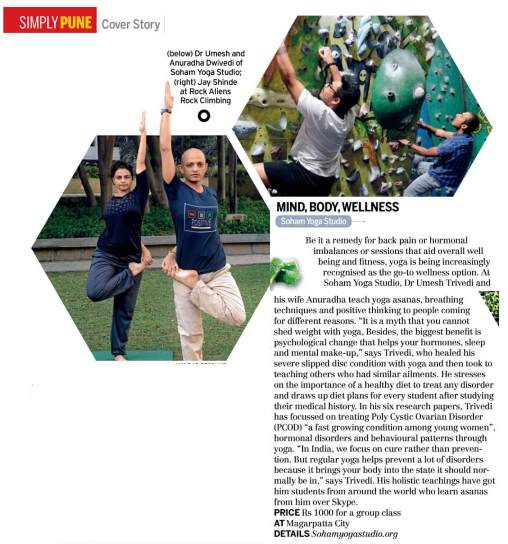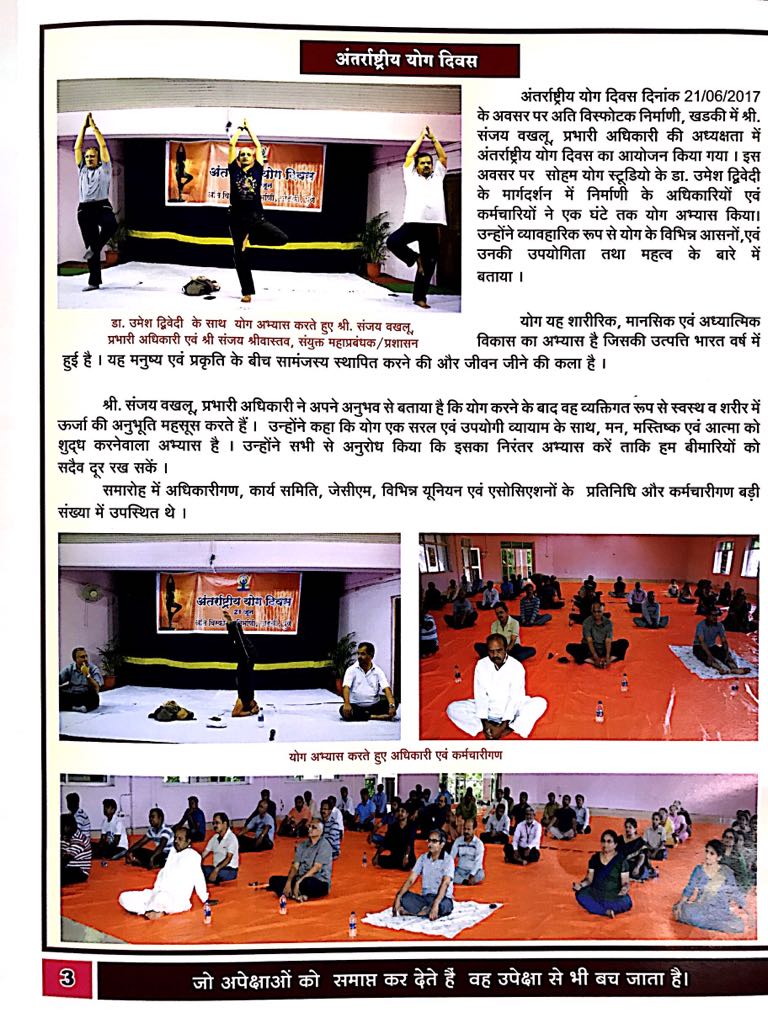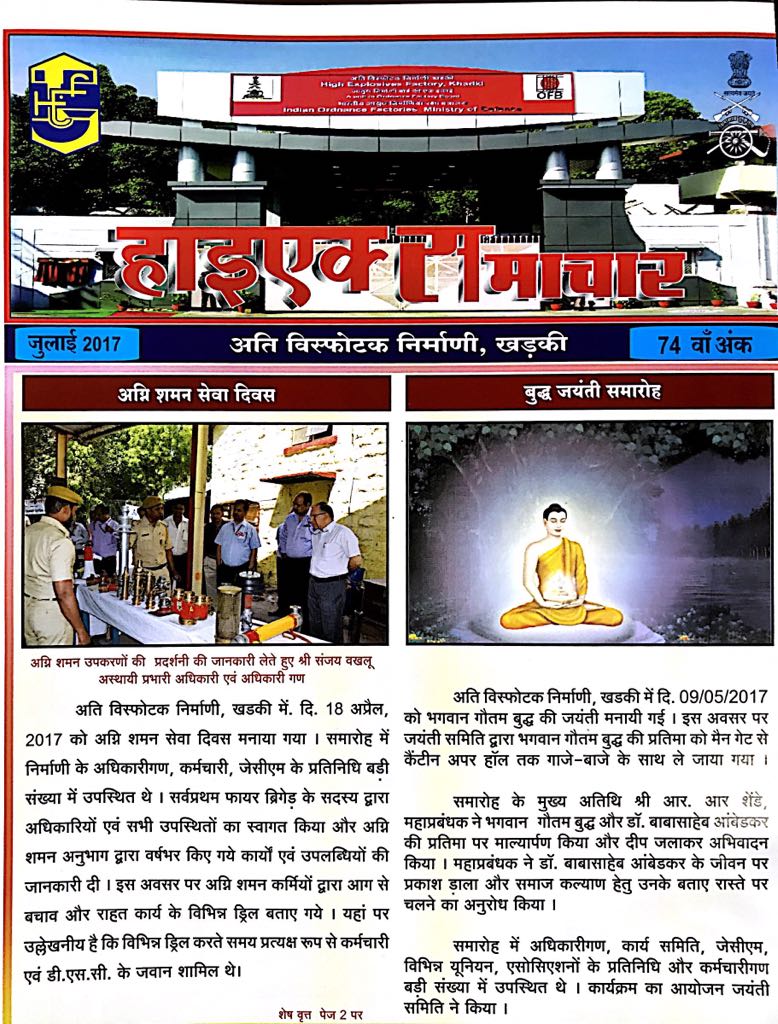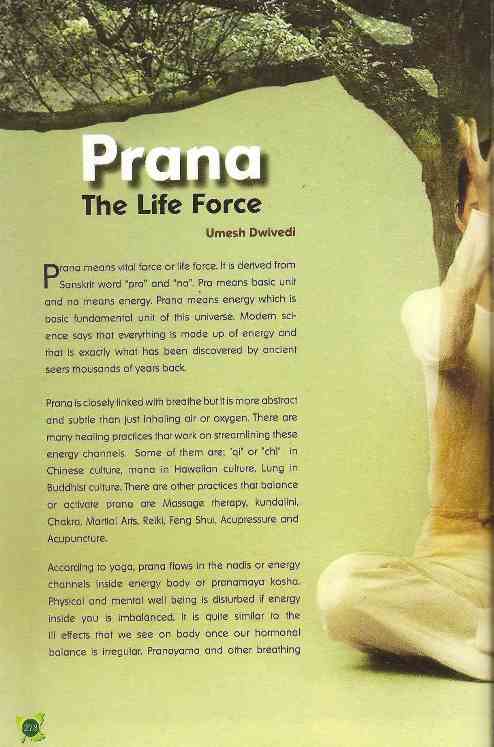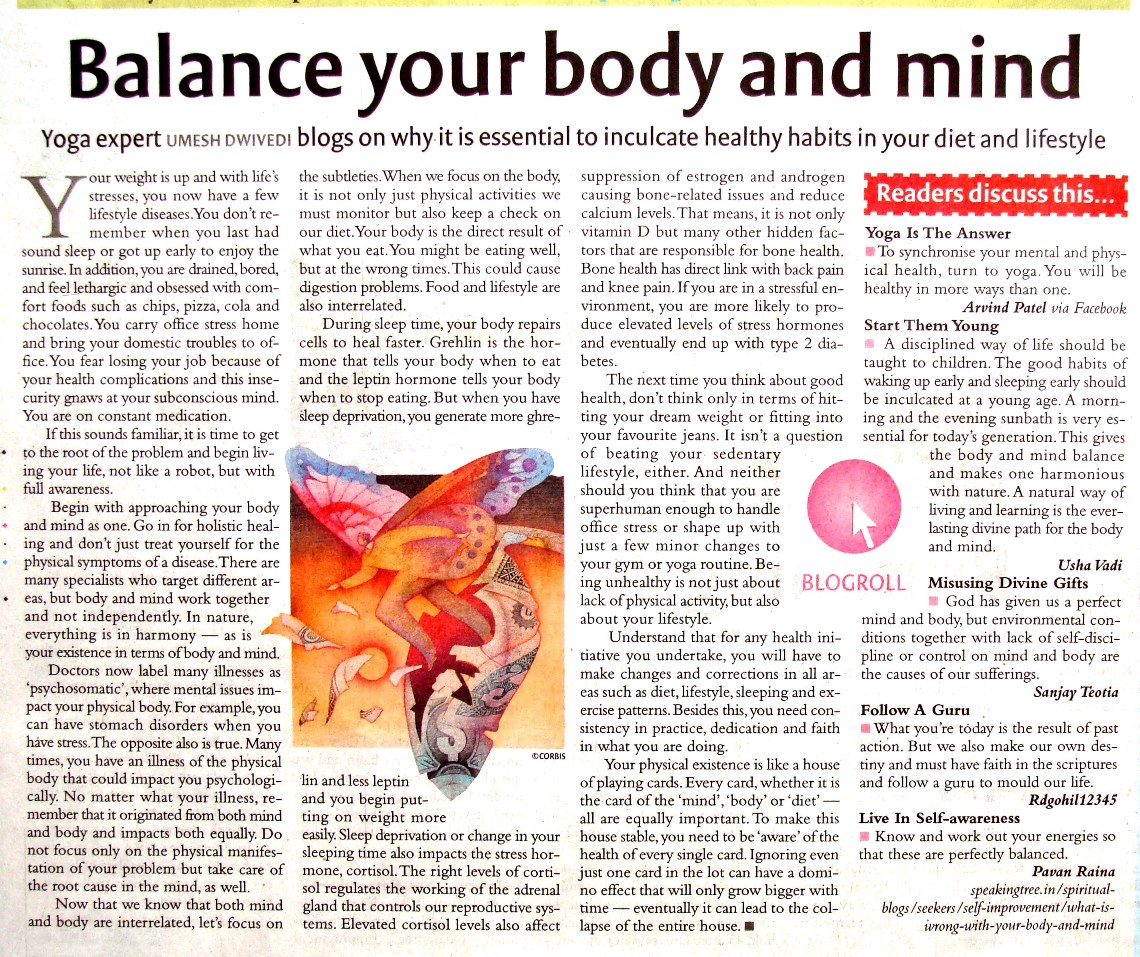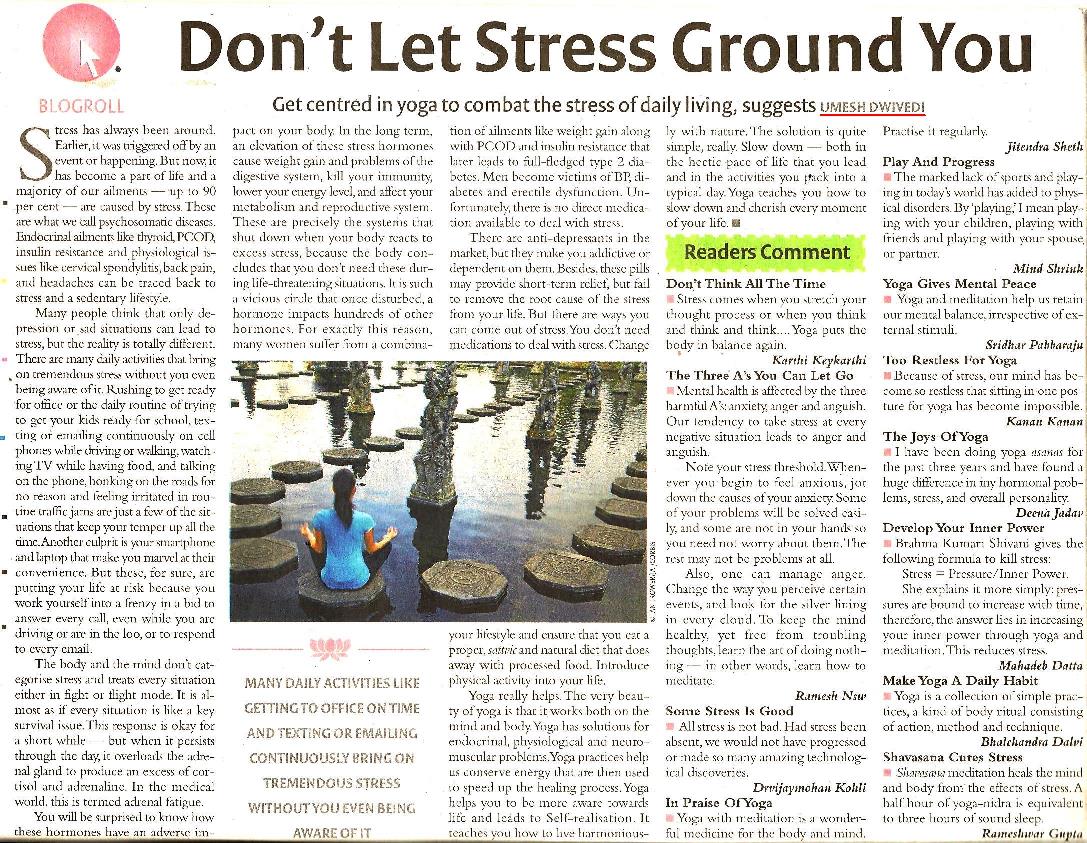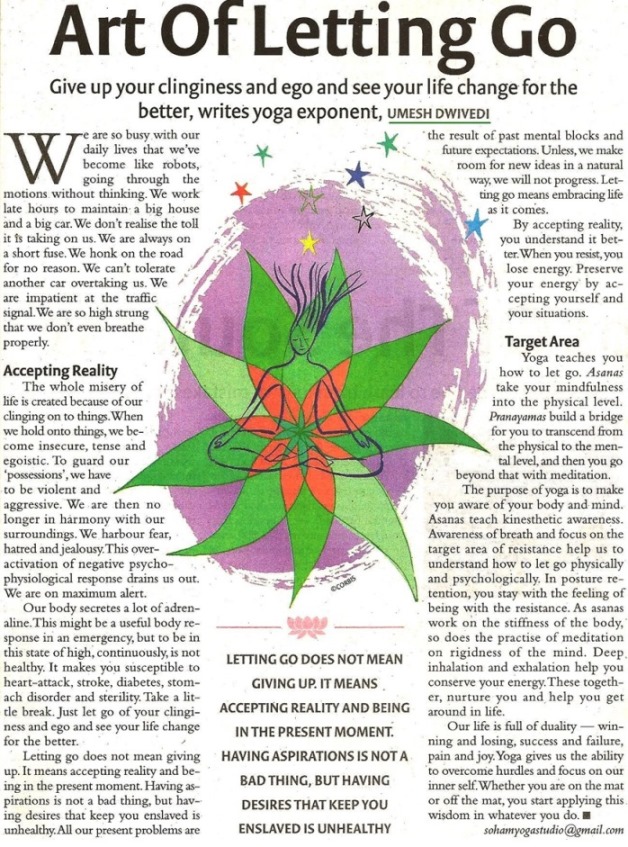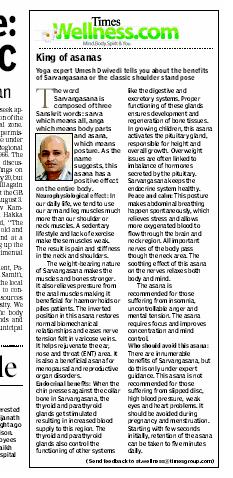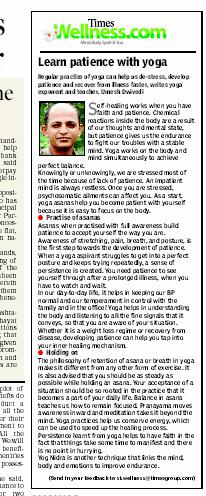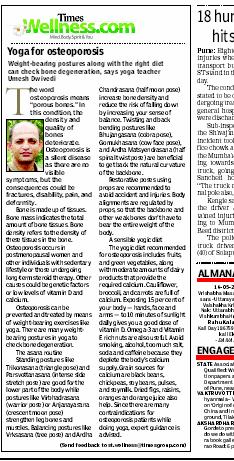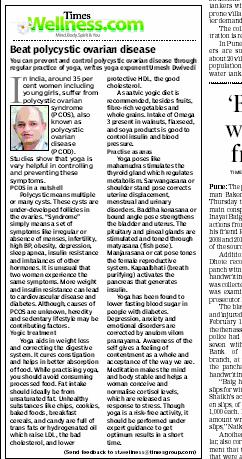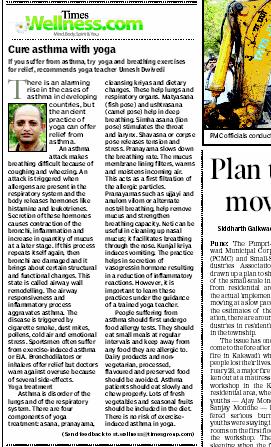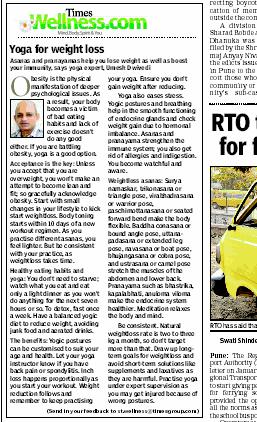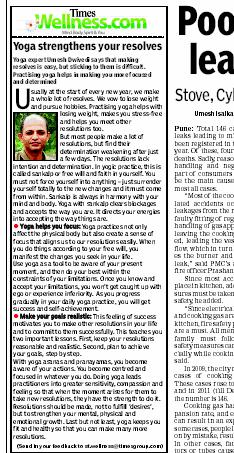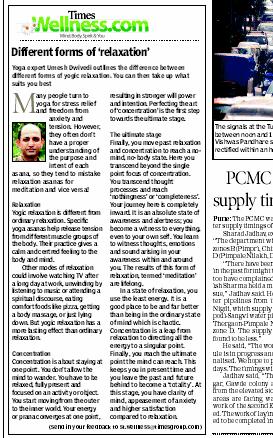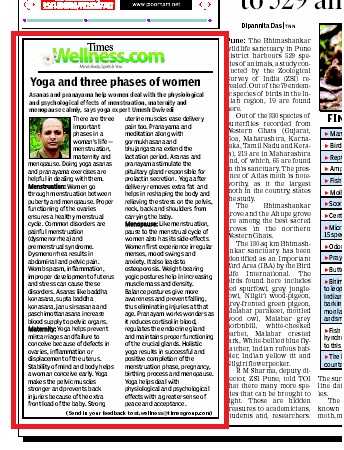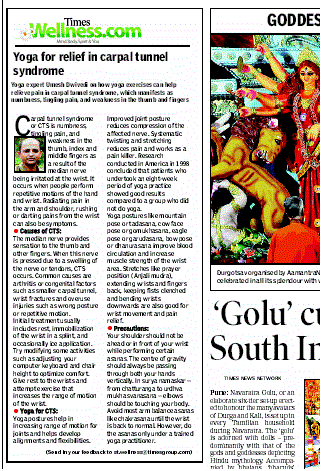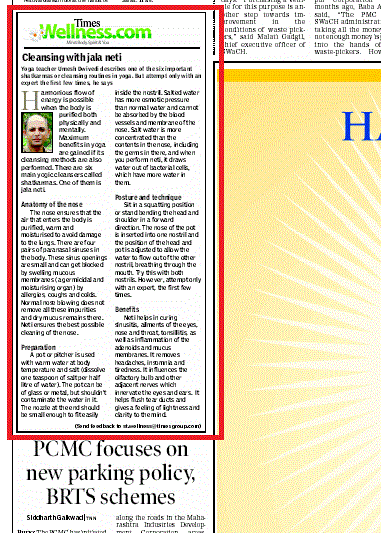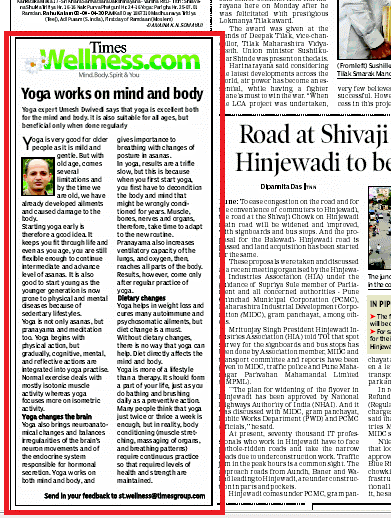King of asanas
Yoga expert Umesh Dwivedi tells you about the benefits of Sarvangasana or the classic shoulder stand pose
The word Sarvangasana is composed of three Sanskrit words: sarva which means all, anga which means body parts and asana, which means posture. As the name suggests, this asana has a positive effect on the entire body.
Neurophysiological effect:
In our daily life, we tend to use our arm and leg muscles much more than our shoulder or neck muscles. A sedentary lifestyle and lack of exercise make these muscles weak. The result is pain and stiffness in the neck and shoulders.
The weight-bearing nature of Sarvangasana makes the muscles and bones stronger. It also relieves pressure from the anal muscles making it beneficial for haemorrhoids or piles patients. The inverted position in this asana restores normal biomechanical relationships and eases nerve tension felt in varicose veins. It helps rejuvenate the ear, nose and throat (ENT) area. It is also a beneficial asana for menopausal and reproductive organ disorders.
Endocrinal benefits:
When the chin presses against the collar bone in Sarvangasana, the thyroid and parathyroid glands get stimulated resulting in increased blood supply to this region. The thyroid and parathyroid glands also control the functioning of other systems like the digestive and excretory systems. Proper functioning of these glands ensures development and regeneration of bone tissues. In growing children, this asana activates the pituitary gland, responsible for height and overall growth. Overweight issues are often linked to imbalance of hormones secreted by the pituitary. Sarvangasana keeps the endocrine system healthy.
Peace and calm:
This posture makes abdominal breathing happen spontaneously, which relieves stress and allows more oxygenated blood to flow through the brain and neck region. All important nerves of the body pass though the neck area. The soothing effect of this asana on the nerves relaxes both body and mind.
The asana is recommended for those suffering from insomnia, uncontrollable anger and mental tension. The asana requires focus and improves concentration and mind control.
Who should avoid this asana:
There are innumerable benefits of Sarvangasana, but do this only under expert guidance. This asana is not recommended for those suffering from slipped disc, high blood pressure, weak eyes and heart problems. It should be avoided during pregnancy and menstruation. Starting with few seconds initially, retention of the asana can be taken to five minutes daily
|
|
|
|
Learn patience with yoga
25th June 2012 - Times of India - Pune Page 4
Regular practise of yoga can help us de-stress, develop patience and recover from illness faster, writes yoga exponent and teacher, Umesh Dwivedi
Self-healing works when you have faith and patience. Chemical
reactions inside the body are a result
of our thoughts and mental state,
but patience gives us the endurance
to fight our troubles with a stable
mind. Yoga works on the body and
mind simultaneously to achieve perfect balance. Knowingly or unknowingly, we are stressed most of the time because of lack of patience. An impatient mind is always restless. Once you are stressed, psychosomatic ailments can affect you. As a start, yoga asanas help you become patient with yourself because it is easy to focus on the body.
Practise of asanas :
Asanas when practised with full awareness build patience to accept yourself the way you are. Awareness of stretching, pain, breath, and posture, is the first step towards the development of patience. When a yoga aspirant struggles to get into a perfect posture and keeps trying repeatedly, a sense of persistence is created. You need patience to see yourself through after a prolonged illness, when you have to watch and wait. In our day-to-day life, it helps in keeping our BP normal and our temperament in control with the family and in the office! Yoga helps in understanding the body and listening to all the fine signals that it conveys, so that you are aware of your situation. Whether it is a weight loss regime or recovery from disease, developing patience can help you tap into your inner healing mechanism.
Holding on :
The philosophy of retention of asana or breath in yoga makes it different from any other form of exercise. It is also advised that you should be as steady as possible while holding an asana. Your acceptance of a situation should be so rooted in the practice that it becomes a part of your daily life. Balance in asana teaches us how to remain focused. Pranayama moves awareness inward and meditation takes it beyond the mind. Yoga practices help us conserve energy, which can be used to speed up the healing process. Persistence learnt from yoga helps to have faith in the fact that things take some time to manifest and there is no point in hurrying. Yog Nidra is another technique that links the mind, body and emotions to improve endurance.
|
|
|
|
Yoga for Osteoporosis
16th Apr 2012 - Times of India - Pune Page 7
Weight-bearing postures along with the right diet can check bone degeneration, says yoga teacher Umesh Dwivedi
The word osteoporosis means "porous bones". In this condition, the density and quality of bones deteriorate. Osteoporosis is a silent disease as there are no visible symptoms, but the consequences could be fractures, disability, pain, and deformity.
Bone is made up of tissues. Bone mass indicates the total amount of bone tissues. Bone density refers to the density of these tissues in the bone. Osteoporosis occurs in postmenopausal women and other individuals with sedentary lifestyle or those undergoing long-term steroid therapy. Other causes could be genetic factors or low levels of vitamin D and calcium.
Osteoporosis can be prevented and treated by means of weight-bearing exercises like yoga. There are many weightbearing postures in yoga to check bone degeneration. The asana routine
Standing postures like Trikonasana (triangle pose) and Parsvottanasana (intense side stretch pose) are good for the lower part of the body while postures like Virbhadrasana (warrior pose) or Anjanayasana (crescent moon pose) strengthen leg bones and muscles. Balancing postures like Vrksasana (tree pose) and Ardha Chandrasana (half moon pose) increase bone density and reduce the risk of falling down by increasing your sense of balance. Twisting and back bending postures like Bhujangasana (cobra pose), Gomukhasana (cow face pose), and Ardha Matsyendrasana (half spinal twist pose) are beneficial to get back the natural curvature of the backbone.
Restorative poses using props are recommended to avoid accident and injuries. Body alignments are regulated by props, so that the backbone and other weak bones don’t have to bear the entire weight of the body.
A sensible yogic diet:
The yogic diet recommended for osteoporosis includes fruits, and green vegetables, along with moderate amounts of dairy products that provide the required calcium. Cauliflower, broccoli, and carrots are full of calcium. Exposing 15 per cent of your body especially hands, face and arms 5 to 10 minutes of sunlight daily gives you a good dose of vitamin D. Omega-3 and Vitamin E rich nuts are also useful. Avoid smoking, alcohol, too much salt, soda and caffeine because they deplete the body’s calcium supply. Grain sources for calcium are black beans, chickpeas, soy beans, pulses, and soymilk. Dried figs, raisins, oranges and orange juice also help. Since there are many contraindications for osteoporosis patients while doing yoga, expert guidance is advised.
|
|
|
|
Beat polycystic ovarian disease
13th Apr 2012 - Times of India - Pune Page 5
You can prevent and control polycystic ovarian disease through regular practice of yoga, writes yoga exponent Umesh Dwivedi
In India, around 35 per cent women including young girls, suffer from polycystic ovarian syndrome (PCOS), also known as polycystic ovarian disease (PCOD). Studies show that yoga is very helpful in controlling and preventing these symptoms.
PCOS in a nutshell :
Polycystic means multiple or many cysts. These cysts are under-developed follicles in the ovaries. "Syndrome" simply means a set of symptoms like irregular or absence of menses, infertility, high BP, obesity, depression, sleep apnea, insulin resistance and imbalances of other hormones. It is unusual that two women experience the same symptoms. More weight and insulin resistance can lead to cardiovascular disease and diabetes. Although, causes of PCOS are unknown, heredity and sedentary lifestyle may be contributing factors.
Yogic treatment:
Yoga aids in weight loss and correcting the digestive system. It cures constipation and helps in better absorption of food. While practising yoga, you should avoid consuming processed food. Fat intake should ideally be from unsaturated fat. Unhealthy substances like chips, cookies, baked foods, breakfast cereals, and candy are full of trans fats or hydrogenated oil which raise LDL, the bad cholesterol, and lower protective HDL, the good cholesterol.
A saatvic yogic diet is recommended, besides fruits, fibre-rich vegetables and whole grains. Intake of Omega 3 present in walnuts, flaxseed, and soya products is good to control insulin and blood pressure.
Practise asanas :
Yoga poses like mahamudra stimulates the thyroid gland which regulates metabolism. Sarwangasana or shoulder stand pose corrects uterine displacement, menstrual and urinary disorders. Baddha konasana or bound angle pose strengthens the bladder and uterus. The pituitary and pineal glands are stimulated and toned through matyasana (fish pose). Manjarasana or cat pose tones the female reproductive system. Kapaalbhati (breath purifying) activates the pancreas that generates insulin.
Yoga has been found to lower fasting blood sugar in people with diabetes. Depression, anxiety and emotional disorders are corrected by anulom vilom pranayama. Awareness of the self gives a feeling of contentment as a whole and acceptance of the way we are. Meditation makes the mind and body stable and helps a woman conceive and normalise cortisol levels, which are released as response to stress. Though yoga is a risk-free activity, it should be performed under expert guidance to get optimum results in a short time.
|
|
|
|
Cure Asthma with yoga
10th March 2012 - Times of India - Pune Page 5
If you suffer from asthma,try yoga and breathing exercises for relief,recommends yoga teacher Umesh Dwivedi
There is an alarming rise in the cases of asthma in developing countries,but the ancient practice of yoga can offer relief from asthma. An asthma attack makes breathing difficult because of coughing and wheezing.An attack is triggered when allergens are present in the respiratory system and the body releases hormones like histamine and leukotrienes.Secretion of these hormones causes contraction of the bronchi,inflammation and increase in quantity of mucus at a later stage.If this process repeats itself again,then bronchi are damaged and it brings about certain structural and functional changes.This state is called airway wall remodelling.The airway responsiveness and inflammatory process aggravates asthma.The disease is triggered by cigarette smoke,dust mites,pollens,cold air and emotional stress.Sportsmen often suffer from exercise-induced asthma or EIA.Bronchodilators or inhalers offer relief but doctors warn against overuse because of several side-effects.
Yoga treatment:
Asthma is disorder of the lungs and of the respiratory system.There are four components of yoga treatment: asana,pranayama,cleansing kriyas and dietary changes.These help lungs and respiratory organs.Matyasana (fish pose) and ushtrasana (camel pose) help in deep breathing.Simha asana (lion pose) stimulates the throat and larynx.Shavasna or corpse pose releases tension and stress.Pranayama slows down the breathing rate.The mucus membrane lining filters,warms and moistens incoming air.This acts as a first filtration of the allergic particles.Pranayamas such as ujjayi and anulom vilom or alternate nostril breathing,help remove mucus and strengthen breathing capacity.Neti can be useful in cleaning up nasal mucus;it facilitates breathing through the nose.Kunjal kriya induces vomiting.The practice helps in secretion of vasopressin hormone resulting in a reduction of inflammatory reactions.However,it is important to learn these practices under the guidance of a trained yoga teacher.
People suffering from asthma should first undergo food allergy tests.They should eat small meals at regular intervals and keep away from any food they are allergic to.Dairy products and nonvegetarian,processed,flavoured and preserved food should be avoided.Asthma patients should eat slowly and chew properly.Lots of fresh vegetables and seasonal fruits should be included in the diet.There is no risk of exerciseinduced asthma in yoga.
|
|
|
|
Yoga for Weight Loss
2nd Feb 2012 - Times of India - Pune/Bangalore, Page 5
Obesity is the physical manifestation of deeper psychological issues. As a result, your body becomes a victim of bad eating habits and lack of exercise doesn’t do any good either. If you are battling obesity, yoga is a good option.
Acceptance is the key:
Unless you accept that you are overweight, you won’t make an attempt to become lean and fit; so gracefully acknowledge obesity. Start with small changes in your lifestyle to kick start weightloss. Body toning starts within 10 days of a new workout regimen. As you practise different asanas, you feel lighter. But be consistent with your practice, as weightloss takes time.
Healthy eating habits and yoga:
You don’t need to starve; watch what you eat and eat only a light dinner as you won’t do anything for the next seven hours or so. To detox, fast once a week. Have a balanced yogic diet to reduce weight, avoiding junk food and aerated drinks.
The benefits:
Yogic postures can be customised to suit your age and health. Let your yoga instructor know if you have back pain or spondylitis. Inch loss happens proportionally as you start your workout. Weight reduction follows and remember to keep practising your yoga. Ensure you don’t gain weight after reducing.
Yoga also eases stress. Yogic postures and breathing help in the smooth functioning of endocrine glands and check weight gain due to hormonal imbalance. Asanas and pranayama strengthen the immune system; you also get rid of allergies and indigestion. You become watchful and aware.
Weightloss asanas:
Surya namaskar, trikonasana or triangle pose, virabhadrasana or warrior pose, paschimottanasana or seated forward bend make the body flexible. Baddha conasana or bound angle pose, uttanapadasana or extended leg pose, navasana or boat pose, bhujangasana or cobra pose, and ustrasana or camel pose stretch the muscles of the abdomen and lower back. Pranayama such as bhastrika, kapalabhati, anuloma viloma make the endocrine system healthier. Meditation relaxes the body and mind.
Be consistent. Natural weightloss rate is two to three kg a month, so don’t target more than that. Draw up longterm goals for weightloss and avoid short-term solutions like supplements and laxatives as they are harmful. Practise yoga under expert supervision as you may get injured because of wrong postures.
|
|
|
|
Yoga strengthens your resolves
2nd Jan 2012 - Times of India - Pune/Bangalore, Page 4
Yoga expert Umesh Dwivedi says that making resolves is easy, but sticking to them is difficult. Practising yoga helps in making you more focused and determined.
Usually at the start of every new year, we make a whole lot of resolves. We vow to lose weight and pursue hobbies. Practising yoga helps with losing weight, makes you stress-free.
and helps you meet other resolutions too. But most people make a lot of resolutions, but find their determination weakening after just
a few days. The resolutions lack intention and determination. In yogic practice, this is called sankalp or free will and faith in yourself. You must not force yourself into anything – just surrender yourself totally to the new changes and it must come from within. Sankalp is always in harmony with your mind and body. Yoga with sankalp clears blockages and accepts the way you are. It directs your energies into accepting the way things are.
Yoga helps you focus:
Yoga practices not only affect the physical body but also create a sense of focus that aligns us to our resolutions easily. When you do things according to your free will, you manifest the changes you seek in your life. Use yoga as a tool to be aware of your present moment, and then do your best within the constraints of your limitations. Once you know and accept your limitations, you won't get caught up with ego or experience inferiority. As you progress gradually in your daily yoga practice, you will get success and self-achievement.
Make your goals realistic:
This feeling of success motivates you to make other resolutions in your life and to commit to them successfully. This teaches you two important lessons. First, keep your resolutions reasonable and realistic. Second, plan to achieve your goals, step by step. With yoga asanas and pranayamas, you become aware of your actions. You become centred and focused in whatever you do. Doing yoga leads practitioners into greater sensitivity, compassion and feeling so that when the moment arises for them to take new resolutions, they have the strength to do it. Resolutions should be made, not to fulfill ’desires’, but to strengthen your mental, physical and emotional growth. Last but not least, yoga keeps you fit and healthy so that you can make many more resolutions.
|
|
|
|
Different forms of Relaxation
8th Dec 2011 - Times of India - Pune, Page 5
Many people turn to yoga for stress relief and freedom from anxiety and tension. However, they often don’t have a proper understanding of the purpose and intent of each asana, so they tend to mistake relaxation asanas for meditation and vice versa.
Relaxation:
Yogic relaxation is different from ordinary relaxation. Specific yoga asanas help release tension from different muscle groups of the body. Their practice gives a calm and centred feeling to the body and mind. Other modes of relaxation could involve watching TV after a long day at work, unwinding by listening to music or attending a spiritual discourse, eating comfort foods like pizza, getting a body massage, or just lying down. But yogic relaxation has a more lasting effect than ordinary relaxation.
Concentration:
Concentration is about staying at one point. You don’t allow the mind to wander. You have to be relaxed, fully present and focused on an activity or object. You start moving from the outer to the inner world. Your energy or prana converges at one point, resulting in stronger will power and intention. Perfecting the art of ’concentration’ is the first step towards the ultimate stage.
The ultimate stage:
Finally, you move past relaxation and concentration to reach a nomind, no-body state. Here you transcend beyond the single point focus of concentration. You transcend thought processes and reach ’nothingness’ or ’completeness’. Your journey here is completely inward. It is an absolute state of awareness and alertness; you become a witness to everything, even to your own self. You learn to witness thoughts, emotions and sound arising in your awareness within and around you. The results of this form of relaxation, termed ’meditation’ are lifelong.
In a state of relaxation, you use the least energy. It is a good place to be and far better than being in the ordinary state of mind which is chaotic. Concentration is a leap from relaxation to directing all the energy to a singular point. Finally, you reach the ultimate point the mind can reach. This keeps you in present time and you leave the past and future behind to become a ’totality’. At this stage, you have clarity of mind, appeasement of anxiety and higher satisfaction compared to relaxation.
|
|
|
|
Yoga and three phases of women
5th November 2011 - Times of India - Pune, Page 5
Asanas and pranayama help women deal with the physiological and psychological effects of menstruation, maternity and menopause calmly, says yoga expert Umesh Dwivedi
There are three important phases in a woman’s life – menstruation, maternity and menopause. Doing yoga asanas and pranayama exercises are helpful in dealing with them.
Menstruation:
Women go through menstruation between puberty and menopause. Proper functioning of the ovaries ensures a healthy menstrual cycle. Common disorders are painful menstruation (dysmenorrhea) and premenstrual syndrome. Dysmenorrhea results in abdominal and pelvic pain. Womb spasm, inflammation, improper development of uterus and stress can cause these disorders. Asanas like baddha konasana, supta baddha konasana, janu sirsasana and paschimottanasana increase blood supply to pelvic organs.
Maternity:
Yoga helps prevent miscarriages and failure to conceive because of defects in ovaries, inflammation or displacement of the uterus. Stability of mind and body helps a woman conceive early. Yoga makes the pelvic muscles stronger and prevents back injuries because of the extra front load of the baby. Strong uterine muscles ease delivery pain too. Pranayama and meditation along with gormukhasana and bhujangasana extend the lactation period. Asanas and pranayama stimulate the pituitary gland responsible for prolactin secretion. Yoga after delivery removes extra fat and helps in reshaping the body and relieving the stress on the pelvis, neck, back and shoulders from carrying the baby.
Menopause:
Like menstruation, pause to the menstrual cycle of women also has its side-effects. Women first experience irregular menses, mood swings and anxiety. It also leads to osteoporosis. Weight-bearing yogic postures help in increasing muscle mass and density. Balance postures give more awareness and prevent falling, thus eliminating injuries at that age. Pranayam works wonders as it reduces cortisol in blood, regulates the endocrine gland and maintains proper functioning of the crucial glands. Holistic yoga results in successful and positive completion of the menstruation phase, pregnancy, birthing process and menopause. Yoga helps deal with physiological and psychological effects with a greater sense of peace and acceptance.
|
|
|
|
Yoga for Carpal Tunnel Syndrome
3rd October 2011 - Times of India - Pune, Page 4
Yoga expert Umesh Dwivedi on how yoga exercises can help relieve pain in carpal tunnel syndrome, which manifests as numbness, tingling pain, and weakness in the thumb and fingers
Carpal tunnel syndrome or CTS is numbness, tingling pain, and weakness in the thumb, index and middle fingers as a result of the median nerve being irritated at the wrist. It occurs when people perform repetitive motions of the hand and wrist. Radiating pain in the arm and shoulder, rushing or darting pains from the wrist can also be symptoms.
Causes of CTS:
The median nerve provides sensation to the thumb and other fingers. When this nerve is pressed due to a swelling of the nerve or tendons, CTS occurs. Common causes are arthritis or congenital factors such as smaller carpal tunnel, wrist fractures and overuse injuries such as wrong posture or repetitive motion. Initial treatment usually includes rest, immobilization of the wrist in a splint, and occasionally ice application. Try modifying some activities such as adjusting your computer keyboard and chair height to optimize comfort. Give rest to the wrists and attempt exercise that increases the range of motion of the wrist.
Yoga for CTS:
Yoga postures help in increasing range of motion for joints and helps develop alignments and flexibilities. Improved joint posture reduces compression of the affected nerve. Systematic twisting and stretching reduces pain and works as a pain killer. Research conducted in America in 1998 concluded that patients who undertook an eight-week period of yoga practice showed good results compared to a group who did not do yoga. Yoga postures like mountain pose or tadasana, cow face pose or gomukhasana, eagle pose or garudasana, bow pose or dhanurasana improve blood circulation and increase muscle strength of the wrist area. Stretches like prayer position (Anjali mudra), extending wrists and fingers back, keeping fists clenched and bending wrists downwards are also good for wrist movement and pain relief.
Precautions:
Your shoulder should not be ahead or in front of your wrist while performing certain asanas. The centre of gravity should always be passing through both your hands vertically. In surya namaskar (from chatturanga to urdhva mukha svanasana) elbows should be touching your body. Avoid most arm balance asanas like chakrasana until the wrist is back to normal. However, do the asanas only under a trained yoga practitioner.
|
|
|
|
Cleansing with jala neti
1st September 2011 - Times of India - Pune
Harmonious flow of energy is possible when the body is purified both physically and mentally.Maximum benefits in yoga are gained if its cleansing methods are also performed.There are six main yogic cleansers called shatkarmas.One of them is jala neti.
Anatomy of the nose:
The nose ensures that the air that enters the body is purified,warm and moisturised to avoid damage to the lungs.There are four pairs of paranasal sinuses in the body.These sinus openings are small and can get blocked by swelling mucous membranes (a germicidal and moisturising organ) by allergies,coughs and colds.Normal nose blowing does not remove all these impurities and dry mucus remains there.Neti ensures the best possible cleaning of the nose.
Preparation:
A pot or pitcher is used with warm water at body temperature and salt (dissolve one teaspoon of salt per half litre of water).The pot can be of glass or metal,but shouldnt contaminate the water in it.The nozzle at the end should be small enough to fit easily inside the nostril.Salted water has more osmotic pressure than normal water and cannot be absorbed by the blood vessels and membrane of the nose.Salt water is more concentrated than the contents in the nose,including the germs in there,and when you perform neti,it draws water out of bacterial cells,which have more water in them.
Posture and technique:
Sit in a squatting position or stand bending the head and shoulder in a forward direction.The nose of the pot is inserted into one nostril and the position of the head and pot is adjusted to allow the water to flow out of the other nostril,breathing through the mouth.Try this with both nostrils.However,attempt only with an expert,the first few times.
Benefits:
Neti helps in curing sinusitis,ailments of the eyes,nose and throat,tonsillitis,as well as inflammation of the adenoids and mucus membranes.It removes headaches,insomnia and tiredness.It influences the olfactory bulb and other adjacent nerves which innervate the eyes and ears.It helps flush tear ducts and gives a feeling of lightness and clarity to the mind.
|
|
|
|
Yoga works on mind and body
2nd August 2011 - Times of India - Pune
Yoga expert Umesh Dwivedi says that yoga is excellent both for the mind and body. It is also suitable for all ages, but beneficial only when done regularly
Yoga is very good for older people as it is mild and gentle. But with old age, comes several limitations and by the time we are old, we have already developed ailments and caused damage to the body. Starting yoga early is therefore a good idea. It keeps you fit through life and even as you age, you are still flexible enough to continue intermediate and advance level of asanas. It is also good to start young as the younger generation is now prone to physical and mental diseases because of sedentary lifestyles. Yoga is not only asanas, but pranayama and meditation too. Yoga begins with physical action, but gradually, cognitive, mental, and reflective actions are integrated into yoga practise. Normal exercise deals with mostly isotonic muscle activity whereas yoga focuses more on isometric activity.
Yoga changes the brain :
Yoga also brings neuroanatomical changes and balances irregularities of the brain’s neuron movements and of the endocrine system responsible for hormonal secretion. Yoga works on both mind and body, and gives importance to breathing with changes of posture in asanas. In yoga, results are a trifle slow, but this is because when you first start yoga, you first have to decondition the body and mind that might be wrongly conditioned for years. Muscle, bones, nerves and organs, therefore, take time to adapt to the new routine. Pranayama also increases ventilatory capacity of the lungs, and oxygen, then, reaches all parts of the body. Results, however, come only after regular practice of yoga.
Dietary changes :
Yoga helps in weight loss and cures many autoimmune and psychosomatic ailments, but diet change is a must. Without dietary changes, there is no way that yoga can help. Diet directly affects the mind and body. Yoga is more of a lifestyle than a therapy. It should form a part of your life, just as you do bathing and brushing daily as a preventive action. Many people think that yoga just twice or thrice a week is enough, but in reality, body conditioning (muscle stretching, massaging of organs, and breathing patterns) require continuous practice so that required levels of health and strength are maintained.
|
|
|
|

